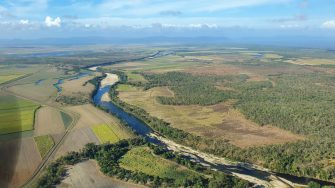
Date: Wednesday, October 2, 2019
Project: Eastern Australian Waterbird Survey
Observers: John Porter & Shannon Dundas
Trainee: Amelia Selles
Pilot: Tim Dugan
Preparing for day 2 at Maroochydore after overnight showers of rain.
Our first counting for day 2 is on some small dams and reservoirs west of Maroochydore. There are not many birds – a few purple swamphen, coot and black swans with the occasional cormorant darter or pelican. From here we head east to a series of lakes and channels connected to the Noosa River; Lake Weyba is a shallow brackish water lake south of Noosa and today there are very few birds. More and more developments have sprung up close to coastal waterbodies in recent years making some of our long term sites difficult to survey since we are restricted in how close to built-up areas we can go.
Counting on Lake Weyba south of Noosa.
From Lake Cooroibah near Noosa we head to our next survey sites north of Bundaberg – the Kolan River estuary, Littabella and Baffle Ck systems. Here we find small numbers of migratory waders, terns and pelicans.
Surveying estuarine channels near Mary River.
We head into Gladstone to refuel before setting course for the floodplain creeks and billabongs of Herbert Creek & the Styx River – in good conditions these wetlands can support many thousands of waterbirds, often with great diversity.
Unfortunately most of the floodplains are very dry and only a few birds are present on most – but there are several hundred grey teal and black duck on one of the billabongs together with a few masked lapwings, glossy ibis and plumed whistling ducks.
Approaching Proserpine Plains.
South of Proserpine are the Proserpine plains – mostly natural creeks and billabongs with a few dams and reservoirs. Many of these wetlands are dry – though on one dam there are several thousand magpie gees and hundreds of grey teal, pink eared duck and black duck; smaller numbers of many other species are also present – white pygmy geese, plumed whistle ducks, burdekin ducks, lapwings stilts cormorants, herons egrets and darter. It was certainly a welcome sight to see higher numbers of birds on at least one wetland today.
